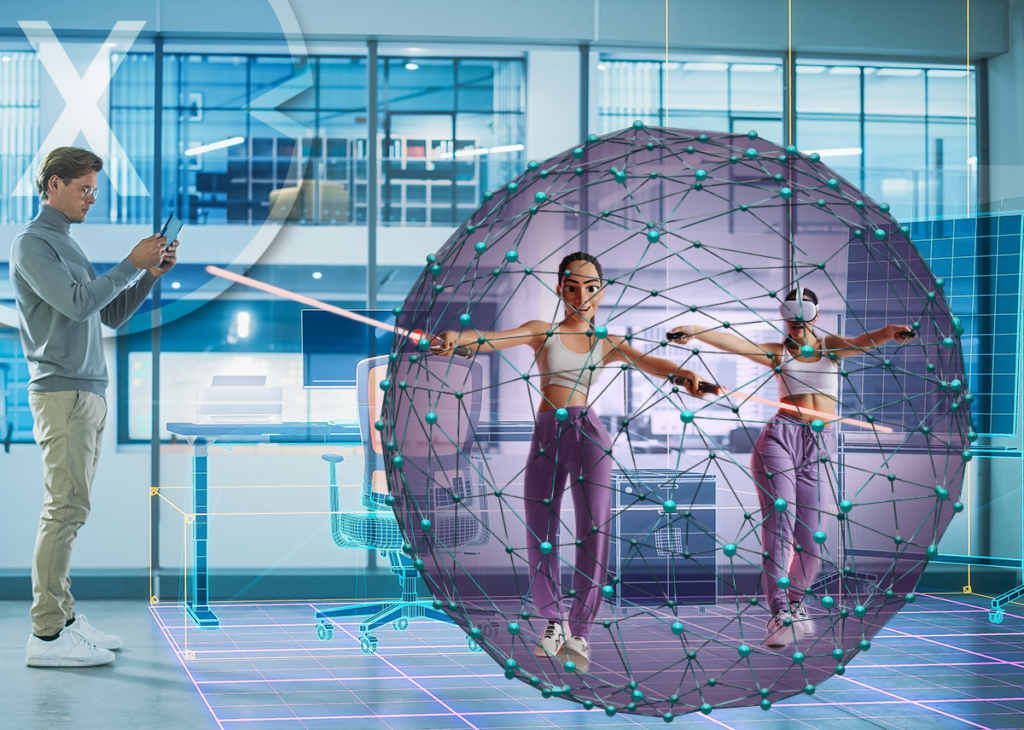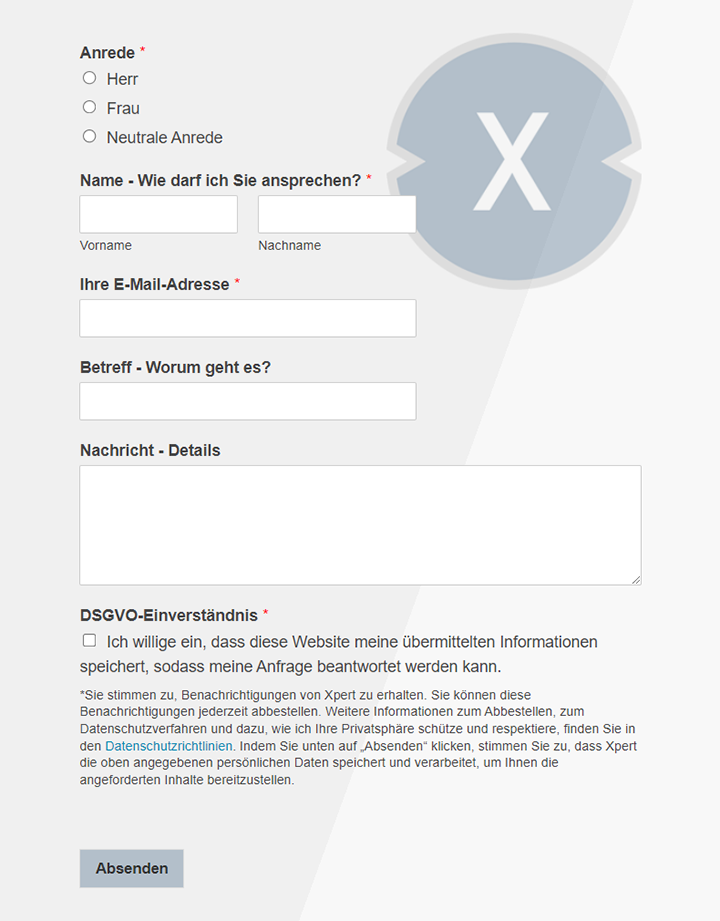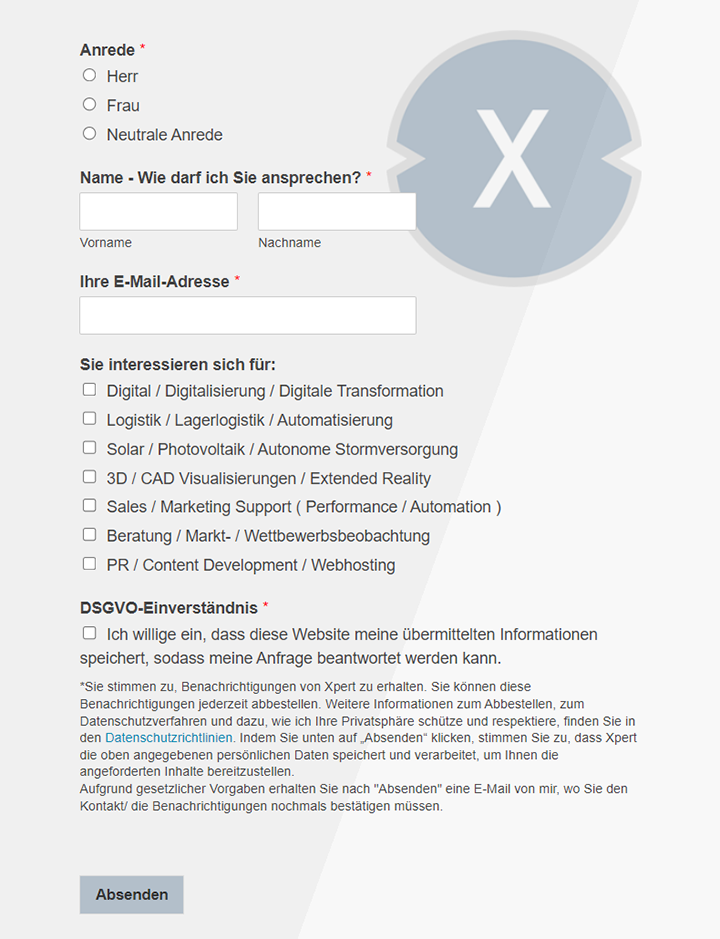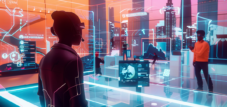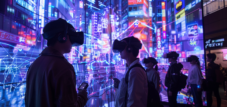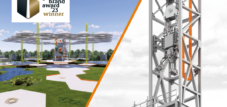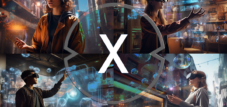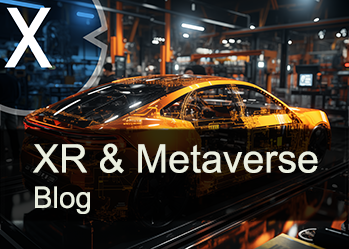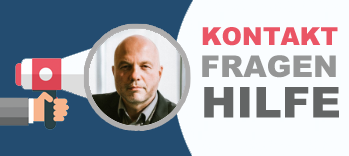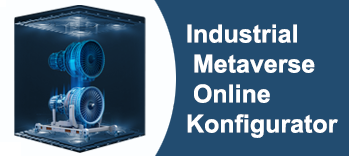Immersive Engineering, collaborative cooperation and what that has to do with the metaverse
Xpert pre-release
Language selection 📢
Published on: February 18, 2025 / update from: February 18, 2025 - Author: Konrad Wolfenstein

Immersive engineering, collaborative cooperation and what that has to do with the metaverse - picture: xpert.digital
VR, AR, XR: These are the tools with which the production is turned around
Immersive engineering and collaborative cooperation in industrial metaverse: a transformative symbiosis
The world of industrial production is a completely new type of product development with Industry 4.0 and industrial meta -verses in the threshold, driven by the fusion of immersive engineering, advanced methods of cooperation and the emerging technologies of metaverse. While the meta -verse in general - often in connection with entertainment and social media - is still struggling for its economic relevance, a specific area emerges that is already acting as a real economy driver: industrial metaverse. This development promises no less than a paradigm shift in the way products are designed, developed, manufactured, manufactured and serviced.
This report illuminates the multi -layered aspects of this transformation and analyzes the technological, organizational and economic implications that result from the integration of immersive engineering and collaborative work in industrial metaverse. We rely on findings from current research initiatives and pioneering industrial projects in order to draw a comprehensive picture of the opportunities and challenges that this development brings.
Suitable for:
Technological foundations of Immersive Engineering in Metaverse
The industrial metaverse builds on a number of key technologies that enable a completely new dimension of product development and production in its combination. At the center of this technological revolution is the immersive engineering, which allows engineers and designers to immerse yourself in virtual, interactive environments and to interact with digital models and simulations as if they were real.
Networked XR ecosystems as an infrastructural basis
A fundamental prerequisite for the realization of industrial meta-severse are powerful and networked XR ecosystems (XR stands for Extended Reality, a umbrella term for virtual reality, augmented reality and mixed reality). Traditional virtual reality glasses, although already established in many areas, often reach their limits in demanding industrial applications. This is where the development of progressive XR infrastructures comes in, which go beyond simple head-mounted displays.
Initiatives such as Instance of Fraunhofer IAO demonstrate the way to the future. A cross-sectoral hardware and software infrastructure is created here based on complex systems. Instead of VR glasses, high-resolution projectors, powerful real-time graphics architectures and precise tracking systems perform. These networked XR laboratories make it possible to interact teams at various locations, simultaneously and in real time with identical virtual prototypes.
A prime example of this development is so-called cave environments (Cave automatic virtual environment), such as those used in the center for virtual engineering. In such rooms, bright 4K projections are used to create Immersive 360 ° representations that allow the user to completely immerse yourself in the virtual world. The precise tracking captures the movements of the users and enables intuitive interaction with the virtual environment, which goes far beyond the possibilities of conventional VR glasses.
The advantage of such networked XR ecosystems lies in their ability to present highly complex virtual environments and at the same time enable the cooperation between distributed teams. Engineers and designers can feel like they are working together on a physical prototype, even though they are actually in different locations. This not only accelerates the development processes, but also promotes creativity and innovation, since teams can exchange effective ideas and develop solutions together.
Hybridization of CAD/PLM systems and XR interfaces
Another critical success factor for immersive engineering in industrial meta -verses is the seamless integration of existing engineering tools and systems in the virtual work environments. In particular, the bidirectional connection of CAD (computer-aided design) and PLM systems (Product Lifecycle Management) at XR interfaces is of crucial importance.
CAD systems are the heart of modern product development. 3D models are created here by components, assemblies and complete products. PLM systems, on the other hand, serve to manage the entire product life cycle, from the first idea to development and production to maintenance and disposal. The integration of these systems into the industrial meta verse enables virtual prototypes to generate directly from the CAD data and to link them to the information from the PLM system in real time.
An example of this development is the NX Immersive Designer of Siemens, which was developed in collaboration with Sony. This solution demonstrates how parametric 3D model data from the CAD system NX can be seamlessly transmitted to Sony mixed reality glasses. The special thing about this is bidirectional communication: design changes that are carried out in the virtual environment are synchronized back into the PLM system in real time.
This so-called “Closed Loop” approach eliminates media breaks and avoids the need to manually transmit data between different systems. It also enables the provision of context -sensitive tool pallets in the virtual environment. This means that the tools and functions that are available to the user in the XR environment dynamically adapt to the current engineering tasks. For example, other tools are required for a design test than with assembly planning or maintenance simulation.
The hybridization of CAD/PLM systems and XR interfaces is therefore a crucial step in making industrial metavers an integral part of the engineering workflow. It enables engineers and designers to continue using their usual tools and processes in an immersive and collaborative environment and at the same time benefit from the advantages of XR technology.
Physically accurate simulation environments
Another important aspect of Immersive Engineering in Metaverse is the option of performing physically accurate simulations in virtual environments. Progresses in areas such as ray tracing engine and physics simulations make it possible to present material properties, flow behavior, mechanical stress and many other physical phenomena in real time and with high accuracy.
Ray tracing engine ensure a realistic representation of light and shadow in the virtual environment. This is not only important for the visual immersion, but also for the assessment of design aspects such as surface quality, reflections and coloring. Physics simulations, on the other hand, enable the behavior of virtual objects to be examined under different conditions. For example, the effects of forces and loads on components can be simulated or the flow behavior of liquids and gases can be analyzed in complex systems.
The AR3S system from Holo-Lights is an example of how such physically accurate simulations can be used in augmented reality. Here results of finite element analyzes (FEA), a method for calculating mechanical stress and deformations, are placed directly as holographic overlays about physical prototypes. This enables engineers to visualize and assess the results of the simulations directly in the context of the real object.
NVIDIA OMNIVERSE is another platform that drives this development forward. Omniverse enables GPU accelerated multiphysics simulations that carry out calculations much faster than conventional CPU-based systems. This leads to a significant acceleration of the iteration cycles in product development. Engineers can simulate and compare different design variants faster, which leads to optimized products and shorter development times. It is reported that the use of such technologies can be reduced by up to 40%.
Physically accurate simulations in industrial metavers thus offer enormous potential to make product development more efficient and high -quality. They make it possible to test and optimize products virtually before physical prototypes have to be built. This not only saves time and costs, but also reduces material consumption and thus contributes to more sustainable product development.
Collaborative work models in industrial metaverse
The industrial metaverse is not only a technological platform, but also a catalyst for new forms of cooperation. The immersive and interactive possibilities of metavers open up completely new perspectives for the collaboration of teams, regardless of their physical location.
Suitable for:
- For hybrid teams: Success factors of collaborative platforms
- What advantages do collaborative platforms offer compared to traditional work models?
Multimodal interaction paradigms
Modern XR systems rely on multimodal interaction paradigms to enable intuitive and natural operation of the virtual environments. Instead of classic keyboard and mouse inputs, various input methods are combined, including voice control, gesture recognition and haptic feedback.
Voice control enables users to issue commands and interact with the virtual environment by simply speaking. Gesture recognition records hand and body movements and translates them into actions in the virtual world. Haptic feedback conveys tactile sensations, for example by vibration engines in controllers or special gloves. This increases the immersion and enables more precise and natural interaction with virtual objects.
The partnership between Siemens and Sony demonstrates the integration of such multimodal interaction paradigms in industrial applications. In their XR solutions, for example, 6thof controllers (6 degrees of freedom) are used, which enable precise manipulation of virtual assemblies. 6thoF means that the controller can record movements in six degrees of freedom: forward/backward, left/right, high/down and twisting around all three axes. This allows very intuitive and precise control in the virtual environment.
In addition, eye-tracking systems are integrated, which capture the direction of view and the focus of the users. Eye tracking can be used in various applications, for example for analyzing the attention distribution in design teams. By evaluating eye data, it can be determined which areas of a virtual prototype are viewed particularly intensely and where there may be design problems or optimization potential.
The multimodality of modern XR systems makes a significant contribution to reducing the training period for new users and increasing the acceptance of the technology. It is reported that the training period can be shortened by an average of 60% compared to classic VR interfaces. This is particularly important in industrial environments, where a variety of employees with different backgrounds and previous knowledge are often supposed to work with the systems.
Asynchronous collaboration by AI-based avatars
Another exciting development in the field of collaborative work models in industrial metaverse is the use of artificial intelligence (AI) to support the asynchronous cooperation. Asynchronous cooperation means that team members do not have to work at a project at the same time and at the same place. This is particularly relevant for globally distributed teams and for projects that are carried out via time zones and different working hours.
AI-based avatars can play a key role here. They are digital representations of team members who can act in the virtual environment in the absence of real people. These avatars can, for example, record decisions, pursue tasks and generate recommendations for action based on historical interaction data.
Aveva, a provider of industrial software, researches intensively on the development of such AVATARE. Her research show that Ki-Avatars can significantly increase consistency in intercontinental development projects. It is reported that an increase in consistency can be achieved by up to 35%. This is because Ki-Avatars can bridge cultural and temporal barriers, for example by documenting information and decisions in a standardized form and making them accessible to all team members, regardless of their location or time zone.
Ki-Avatars can also help to avoid loss of knowledge and to ensure continuity in projects. If a team member leaves or goes on vacation, his Ki-Avatar can continue to take on tasks and ensure that important information and decisions are not lost.
It is important to emphasize that AI Avatars are not intended to replace human employees. Rather, they should serve as supportive tools that improve the efficiency and effectiveness of the collaboration and enable teams to successfully work together in complex and distributed environments.
Suitable for:
- MMM – Metaverse medium-sized businesses and mechanical engineering in 5G: 5G technology in the Troisdorf Industrial City Park with VR glasses and avatars
- How can collaborative platforms improve collaboration between different departments within a company?
Context -adaptive knowledge databases
Another important aspect of collaborative working models in industrial metaverse is the integration of context -adaptive knowledge databases. In complex engineering projects, there are huge amounts of information and data, including CAD models, material data sheets, standards, guidelines, previous project information and much more. The challenge is to make this information available for the employees involved at the right time and in the right context.
Integrated knowledge graphs can offer a solution here. Knowledge graphs are semantic networks that present information in the form of knots and edges and map relationships between different information elements. In the context of the industrial meta verse, knowledge graphs can, for example, link CAD models with standards, material data sheets and historical project information.
DXC Technology, an IT service company, uses meta-verse environments to display this data context-sensitive as holographic overlays. If an engineer looks at a certain component in the virtual environment, relevant information from the knowledge graph is automatically displayed, such as material specifications, manufacturing guidelines or results of previous tests.
It is reported that the use of such contextic knowledge databases can reduce the error rate in design reviews by up to 28%. This is because engineers can access relevant information faster and easier and can therefore make more and more well -founded decisions.
In addition, machine learning algorithms can be used to analyze the user interactions in the virtual environment and proactively suggest relevant information. For example, if an engineer often searches for certain standards or material data, the system can automatically put this information into the foreground or even show a proactively before the user has to search for it.
Context -IFTAVE knowledge databases in industrial metavers thus help to manage the flood of information and ensure that engineers and designers have access to the required information at any time in order to be able to work more efficiently and error -free.
Economic implications and market development
The integration of immersive engineering and collaborative work in industrial metaverse is not only technologically exciting, but also promises considerable economic advantages. The market development in this area is dynamic and promising growth prospects are emerging.
🗒️ Xpert.Digital: A pioneer in the field of extended and augmented reality
Growth forecast and investment strategies - background analysis
Market research & innovation: Why the metaverse transforms industry
Market research companies such as ABI Research predict impressive growth for the industrial meta-verse market. An average annual growth rate (CAGR) of 32.05% by 2034 is assumed. The focus of companies is increasingly on slim implementations with a clear and short -term return on investment (ROI).
A study by Deloitte identifies three main clusters of investment strategies in industrial metavers:
Digital twins
About 45% of companies prioritize investments in digital twins. Digital twins are virtual representations of physical objects, processes or systems. They enable companies to simulate, analyze and optimize their real processes in the virtual world.
AI-based collaboration tools
Around 30% of companies rely on AI-based collaboration tools. These tools are intended to improve the cooperation of teams, support knowledge management and optimize decision -making processes.
Own XR ecosystems
About 25% of companies develop their own XR ecosystems. This includes building your own hard and software infrastructure for immersive engineering and collaborative applications in meta-verses.
The partnership between Siemens and Sony is an example of how strategic alliances can reduce the development costs in industrial meta -verse. Through technology sharing and the common use of know-how, companies can bundle their resources and drive innovations faster. It is reported that such partnerships can reduce development costs by up to 40%.
Return on Investment (ROI) analyzed
Investments in immersive engineering and collaborative technologies in industrial meta -verses pay off for companies in a variety of ways. Numerous studies and industrial projects show the positive ROI of these technologies.
An important advantage is to reduce physical prototypes and test cycles by virtual prototyping. By using simulations and virtual models, products can be extensively tested and optimized before physical prototypes have to be built. It is reported that virtual prototyping can reduce the number of physical test cycles by an average of 62%. This not only saves material costs, but also valuable development time.
Simultaneous multidisciplinary reviews in virtual environments also contribute to the acceleration of product development. Due to the possibility that teams from various specialist areas can examine and discuss virtual prototypes together at the same time and together, coordination processes are more efficient and decisions are made faster. It is reported that such simultaneous reviews can shorten the time-to-market by up to 35%.
The “Iguversum” of Igus, a manufacturer of plastic products, demonstrates the savings potential through virtualized automation tests. Igus uses virtual environments to plan, test and optimize automation systems. It is reported that Igus achieves annual savings of € 780,000 by using the igu verification and at the same time reduces travel expenses by 89%.
Suitable for:
Burckhardt Compression, a manufacturer of compressor systems, uses augmented reality (AR) to maintain its systems. AR-based maintenance instructions and remote support can be carried out more efficiently and effectively. It is reported that Burckhardt compression achieves 43% higher system availability by AR-based maintenance.
These examples show that the ROI of immersive engineering and collaborative technologies in industrial metavers in various areas of application and industries is significant. The advantages range from cost savings and time savings to quality improvements and increased system availability.
New business models and value chains
The development of industrial metavers not only leads to efficiency increases and cost savings in existing business models, but also opens up completely new business models and value chains.
An example of this are Metaverse-as-A-Service platforms that offer pay-per-use access to high-end simulation resources. Especially for small and medium -sized companies (SME), access to expensive simulation software and hardware can be a major hurdle. Metaverse-as-a-service platforms enable these companies to use simulation resources as required and inexpensive without having to make high preliminary investments.
“XR Now” by Holo-Light is an example of such a platform. XR Now offers pay-per-us access to supercomputing resources for XR applications. It is reported that companies can receive the use of supercomputing resources for only € 0.12 per GPU hour. This harbors disruptive potential in particular for medium -sized companies, since it also enables smaller companies to carry out complex simulations and benefit from the advantages of immersive engineering.
At the same time, specialized consulting services for the integration of XR develop into existing PLM processes. The introduction of immersive engineering and meta-verse technologies in companies often requires profound changes in processes, structures and skills. Consulting companies support companies in successfully designing this transformation. It is predicted that the market for such consulting services will reach a volume of € 12.4 billion by 2026.
The development of industrial metaverse not only creates new opportunities for companies to improve their products and processes, but also to develop innovative services and business models for new companies.
Future of collaboration: How OpenXRT and Blockchain shape the industrial meta verse
Despite the great potential of industrial metavers, there are also challenges and critical success factors that companies have to take into account when implementing.
Suitable for:
Interoperability and standardization
One of the greatest challenges is the heterogeneity of XR formats and CAD systems. There is a variety of different file formats, tracking protocols and physics engine, which are often not compatible with each other. This makes it difficult to exchange data and cooperation between different systems and platforms.
In order to cope with this challenge, standardization initiatives are of crucial importance. The Fraunhofer IAO, for example, is working on an “OpenXRT” standard that aims to standardize file formats, tracking protocols and physics engine. The aim is to create an open and interoperable standard for XR technologies in an industrial context.
First tests with the OpenXRT standard show promising results. It is reported that data conversion times can be reduced by up to 70%, while the model accuracy is improved by 92%. Such a standard would significantly simplify the data exchange between different XR systems and engineering tools and increase the efficiency of the development processes.
Data security in distributed environments
Another important aspect is data security in distributed environments. In industrial metavers, sensitive construction data and production information are often exchanged across various locations and partners. It is therefore crucial to ensure that this data is protected against unauthorized access and manipulation.
Blockchain-based solutions such as the “Industrial Data Space” from Siemens offer promising approaches here. The Industrial Data Space enables safe and confident data exchange between companies. The use of blockchain technology and zero-knowledge-proofs ensures that sensitive data can only be viewed and used by authorized parties while the privacy is preserved at the same time.
Encrypted data ticks make it possible to award temporary access rights for external partners without completely exposing the central PLM system. This is particularly important for cooperation with suppliers and service providers who may only need access to certain data for a limited period of time.
Data security and data protection are therefore central success factors for acceptance and the use of industrial meta verse in companies. Robust security concepts and technologies are essential to gain the trust of companies in these new technologies and to ensure the protection of sensitive data.
Qualification development and change management
The introduction of immersive engineering and meta-verse technologies not only requires technological adjustments, but also comprehensive qualification development and effective change management. Employees must be trained for working with the new technologies and prepared for the changed ways of working.
DXC Technology reports about 200-hour qualification programs that are specially tailored to the needs of industrial meta-severse. These programs convey both technical skills in dealing with XR systems and simulation software as well as collaborative soft skills that are essential for working in virtual teams.
Gamification elements are used in these qualification programs to increase the motivation and commitment of the participants. It is reported that Gamification increases the final rate of qualification programs significantly. Compared to traditional training, in which the final rate is often around 67%, VR-based qualification programs with gamification elements achieve final rates of up to 89%.
At the same time, it is important to institutionalize cultural change that goes hand in hand with the introduction of industrial metavers. A study by the MLC (Manufacturing Leadership Council) shows that 68% of the manufacturing companies are establishing dedicated meta-verse departments in order to actively shape the cultural change and to promote the integration of the new technologies.
Qualification development and change management are therefore crucial success factors for the successful implementation of industrial metavers. Companies must invest in the training and further education of their employees and promote a corporate culture that supports openness to innovation and new ways of working.
Quantum computing in industrial metaverse: simulations of the future
The development of industrial metavers is still at the beginning, and there are already exciting future prospects and focus on research that will further increase the potential of these technologies.
Neuroca adaptive XR systems
A promising research area are neurocaptive XR systems based on Brain-Computer interfaces (BCI). BCI enable direct communication between the human brain and a computer. In the context of the industrial meta verse, BCI could be used to integrate cognitive signals directly into design processes and to make interaction with virtual environments even more intuitive and efficient.
The first prototypes of the Fraunhofer IAO are already demonstrating the possibilities of neurocadaptive XR systems. These systems read EEG data (electroencephalogram) in order to identify stress levels in virtual meetings and automatically adapt the ambient brightness. The aim is to optimize the working conditions in virtual environments and reduce the cognitive stress on the users.
Sony experimented with FMRI-based systems (functional magnetic resonance imaging) that record unconscious design preferences and use as inputs for generative AI systems. Based on these preferences, generative AI can then automatically generate design suggestions and accelerate and improve the design process.
NeuroDaptive XR systems have the potential to fundamentally change interaction with virtual environments and to enable new forms of human-computer interaction. However, a lot of research is still required to bring these technologies to market maturity and to clarify ethical questions in connection with the use of brain data.
Quantum computing for real-time simulations
Another promising future perspective is the use of quantum computing for real-time simulations in industrial metavers. Quantum computers use the principles of quantum mechanics to solve certain computing tasks much faster than classic computers.
The combination of quanta simulators with XR visualization could reduce the calculation of complex flow analyzes or material simulations from weeks to minutes. This would accelerate the iteration cycles in product development again considerably and expand the possibilities for virtual tests and optimizations.
Research projects at ETH Zurich show the first successes in the quantum prediction of material fatigue. The results of these simulations can be visualized as holographic damage cards and used in industrial metaverse to test components virtually for their lifespan and reliability.
Quantum computing has the potential to revolutionize simulation technologies in industrial meta -verses and open completely new areas of application. However, quantum computing is still in an early stage of development, and it will take some time before this technology can be used in industrial applications.
Sustainability potential by virtual factories
The industrial metaverse also offers significant sustainability potential. Digital twins enable the energy -optimized planning of production systems in the design phase. By simulating various production scenarios and energy flows, companies can optimize and protect the energy consumption of their factories.
Freyr, a manufacturer of battery cells, uses Gigafactory simulations to reduce the energy consumption of its production facilities. It is reported that Freyr can reduce energy consumption by 23% by virtual balancing production lines.
AI-supported logistics simulations in industrial metaverse can also help to improve the sustainability of supply chains. By optimizing transport routes and warehousing, companies can reduce CO2 emissions in their supply chain. It is reported that AI-based logistics simulations can reduce CO2 emissions in the supply chain by an average of 18%.
Virtual factories in industrial metavers make it possible to plan, simulate and optimize production processes without consuming physical resources. This contributes to a more sustainable production and supports companies in their efforts to improve their environmental balance.
Synthesis and recommendations for action
The analysis shows that immersive engineering in industrial metaverse is not a futuristic vision, but an operational lever for competitive innovations. Companies that strategically tackle this development can achieve significant advantages and position themselves at the head of a new era of engineering.
For decision -makers in companies, this results in the following recommendations for action:
Pursue incremental implementation strategies
Start with clearly defined use cases that promise a fast ROI. Virtual design reviews or AR-based maintenance are good entry points to gain initial experience and promote acceptance in the company.
Establish interdisciplinary competence centers
Create teams that bring together experts from IT, mechanical engineering and cognitive sciences. These teams can develop user-centered XR solutions that are tailored to the specific needs of the company.
Priorit open ecosystems
Place on open standards and modular architectures that ensure flexibility and adaptability through API interfaces. This enables quick integration of new technology generations and avoids Vendor-Lock-in effects.
Implement ethics guidelines for AI collaboration
Develop clear guidelines for the use of AI in collaborative environments. Transparency in algorithmic decision -making processes and human control instances are essential to create trust and minimize ethical risks.
Collaborative, immersive and transformative
The development of the industrial meta -severse will significantly depend on the extent to which IMSIVE technologies are not able to understand as isolated tools, but as an integral part of networked value chains. Companies that strategically tackle this transformation and take into account the recommendations for action will be able to exploit the full potential of industrial meta verse and to secure a decisive competitive advantage. The future of engineering has started and it is immersive, collaborative and transformative.
We are there for you - advice - planning - implementation - project management
Xpert.Digital - Pioneer Business Development
Smart Glasses & KI - XR/AR/VR/MR industry expert
Consumer metaverse or meta -verse in general
If you have any questions, further information and advice, please feel free to contact me at any time.
I would be happy to serve as your personal advisor.
You can contact me by filling out the contact form below or simply call me on +49 89 89 674 804 (Munich) .
I'm looking forward to our joint project.
Xpert.Digital - Konrad Wolfenstein
Xpert.Digital is a hub for industry with a focus on digitalization, mechanical engineering, logistics/intralogistics and photovoltaics.
With our 360° business development solution, we support well-known companies from new business to after sales.
Market intelligence, smarketing, marketing automation, content development, PR, mail campaigns, personalized social media and lead nurturing are part of our digital tools.
You can find out more at: www.xpert.digital - www.xpert.solar - www.xpert.plus



